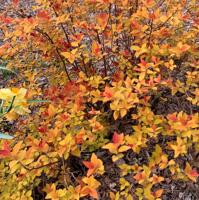Have you thought about adding some plants to your garden that are different from what you usually plant? You might want to add a few Agapanthus to give your garden a more dramatic look.
The dense umbellate flower clusters, held on long, strong stems, rise above clumps of long, strappy foliage. They are most often thought of as indigo-blue but are also white, purple and pink. Agapanthus stand up tall and add a flamboyant touch to any mid-summer garden. They are great as a mass planting, in a container by a pool or tucked in among a perennial border, adding an exotic flair to any location.
The spectacular spherical flower clusters are packed with between 20 and 100 tubular or bell-shaped flowers joined to make the round globe. The flower stands tall on a slender, erect, sturdy stem above green foliage.

Agapanthuses flower from June to early August. Betty Montgomery/Provided
These garden jewels come from South Africa and were once mainly grown in Florida and parts of California, in hot climates. Today, you can find varieties of Agapanthus that grow in colder regions and are becoming more and more popular. I have had them growing in several different places in my USDA zone 7 garden starting 2011. And now there are newer varieties that will grow in colder areas like zone 6.
Agapanthus takes center stage when in bloom. They flower from June to early August, with some varieties being rebloomers and extending the season to late summer. They love to soak up sun, so full sun is ideal for these plants. Well-drained soil is best, but they have been known to grow in heavy clay and they will grow in sandy soil, too.
I have tried about a half dozen different ones through the years. Ted Stevens at Nurseries Caroliniana outside Augusta, Ga., told me about "Bressingham Blue," one variety that was developed in England. I was thrilled when it bloomed and returned the following year. The size of this plant was much smaller than ones I have seen in different warm climates. It had a striking, dark amethyst-blue flower above foliage that was also much smaller than expected. I was quick to point it out to my friends, because few had ever seen an Agapanthus blooming outside of Florida or California.
"Storm Cloud" was another more cold-hardy variety I learned about from Dan Hinkley, a noted plantsman. Hinkley said it was “a vigorous and heavenly flowering form, creating a roll of deep-blue thunder on sturdy stems to 3.5 feet.” My "Storm Cloud" plants have never grown quite as large as Hinkley describes, but the flowers are noticeably larger than "Bressingham Blue" or "Summer Skies," two of my early purchases.
However, today I have some that are at least 36 inches tall with flower clusters 4 to 5 inches across. These are called "Galaxy Blue" and "Galaxy White." These are my favorite and are by far the hardiest I have grown. These two have bloomed reliably for me for about four years. And, according to Walters Garden in Michigan, and I quote: “these varieties have overwintered in our heavy snow winters for the more than seven years. They're out of this world with globular clusters that are produced on tall stems over large, rounded clumps of foliage.”
In my garden, after four years, the clumps are really large — so large that I had originally planted them too close together and have had to relocate every other plant to give them room to grow.
I have recently heard of one that Proven Winners promotes called "Little Galaxy." It is about a foot shorter than "Galaxy Blue" and a softer shade of blue. It is said to work nicely in smaller spaces or containers. Despite its shorter habit, they say that the globes of indigo blue flowers are just as big as its taller companions. This sounds great for the front of the perennial border.

"Galaxy White" Agapanthuses are some of the hardiest forms of the flower. Betty Montgomery/Provided
These gorgeous clusters of blue flowers die back to the ground in the winter in cold regions, but when spring arrives the foliage will bounce back and be as pretty as ever. If you have room, the "Galaxy Blue" are worth finding.
Agapanthus are also deer- and rabbit-resistant. I live in the country and have lots of deer rooming; they have never eaten the foliage or flowers. They do attract hummingbirds and butterflies to the garden, which is a welcomed sight.
I am partial to the blue Agapanthus, I guess because you do not see as many true-blue flowers in the heat of summer. They make excellent cut flowers, and they look great by themselves or mixed with other summer blossoms.
I love to arrange them with Butterfly weed and daylilies that bloom at the same time. But I usually only pick a few, because I love looking at them in the garden.
The best time to fertilize these jewels is in the spring or early summer, allowing time for the fertilizer to work its way to the roots well before flowering. If your soil is very acidic like mine, put a little lime around your Agapanthus to make the soil a little more neutral. This will keep them flowering well from year to year. I crush a little egg shell around them to give them some calcium. If you prefer, buy a fertilizer with all the trace elements so that they get enough calcium. This will help them put up pretty foliage and keep them blooming longer.

Agapanthus and daylilies from Betty Montgomery's garden. Betty Montgomery/Provided
If you do not see them at your local garden center, ask them to order some for you or find them in a bulb catalog. They are well worth having and will live a long time.













